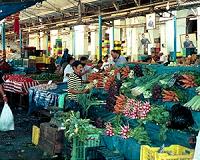 |
University Park PA (SPX) May 26, 2011 Farmers using a cover crop seeder developed by Penn State agricultural scientists may eventually need only a single trip across the field to accomplish what takes most farmers three passes and several pieces of equipment to do. Pennsylvania farmers are increasingly interested in growing cover crops, but the time, cost and late fall harvest of corn and other crops often limit their use, said Gregory Roth, professor of agronomy. The seeder can help farmers, especially small operations, save time and money by condensing multiple tasks into one trip through a no-till field. It would also allow farmers to seed fields that lacked cover crops due to late season and cost concerns. "It can do three things in one pass," Roth said. "It can seed the cover crop, add fertilizer and spray an herbicide to kill emerged weeds." Unlike plowing, no-till farming uses a minimal amount of ground disturbance when planting seeds, a method that improves the soil and prevents erosion. Cover crops play an important role in reducing runoff and helping to build organic material in the soil during the fall and spring. A tractor pulls the seeder through the cornfield rows using a sensor to guide the device between the rows. The device has several blades that lightly till the ground between the cornrows creating a planting swath. The seeds drop onto the soil and a follow-up roller packs the seed into place. At the same time, the machine strategically applies a fertilizer and herbicide. The research team created a prototype using a number of existing technologies from agricultural equipment manufacturers. According to Roth, the best time to use the device is six weeks after the corn is planted. If the cover crop is planted too early, it can compete with the corn plants; if it is planted too late, the corn crop may be too competitive for the cover crop to grow. A single pass through a field costs the farmer approximately $10 an acre, Roth said. By saving one to two trips through the fields, farmers could save $10 to $20 per acre. Other methods of planting cover crops during the growing season - such as using an airplane to drop seeds on the field - are expensive and only moderately successful. Roth said the alternative methods are only effective in establishing a cover crop about half the time. The researchers tested the seeder last summer in three studies at Penn State's Russell E. Larson Agricultural Research Center, said William Curran, professor of weed sciences. In each of the studies, the crop seeder was successful in establishing cover crops without any impact on corn yields. The researchers tested three cover crops - annual ryegrass, red clover and white clover. They also tested a mixture of ryegrass and clover. Because ryegrass and clover can prevent soil erosion and serve as a natural source of nitrogen, farmers also may not need to purchase as much fertilizer. "We picked cover crops that we thought would work and chose the ones that we thought had the best chance to be successful," Curran said. The researchers said they are pleased with the results of the first tests, but have more work to do to perfect the seeder. "We really had just one season for research and we basically tested things that we were pretty sure would be successful," said Curran. "Now we have to do more research before we feel the results are of value and we feel confident in what we're doing." If the seeder is marketed, the researchers believe that the device will be inexpensive enough for use on smaller farms. The researchers have filed a provisional patent on this device. A video explaination of the work is here.
Share This Article With Planet Earth
Related Links Penn State Farming Today - Suppliers and Technology
 Africa turmoil looms over food price rise
Africa turmoil looms over food price rise Nairobi, Kenya (UPI) May 25, 2011 Africa is facing what African Development Bank President Donald Kaberuka calls a "Molotov cocktail" of rising food and oil prices that analysts fear could trigger widespread political upheaval like that which has swept the Arab world since January. There are concerns that the turmoil in North Africa, embracing Egypt, Tunisia, Libya, Morocco and Algeria, could mutate south into the sub-S ... read more |
|
| The content herein, unless otherwise known to be public domain, are Copyright 1995-2010 - SpaceDaily. AFP and UPI Wire Stories are copyright Agence France-Presse and United Press International. ESA Portal Reports are copyright European Space Agency. All NASA sourced material is public domain. Additional copyrights may apply in whole or part to other bona fide parties. Advertising does not imply endorsement,agreement or approval of any opinions, statements or information provided by SpaceDaily on any Web page published or hosted by SpaceDaily. Privacy Statement |